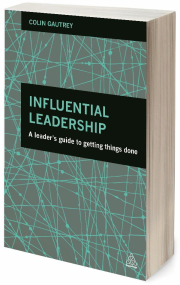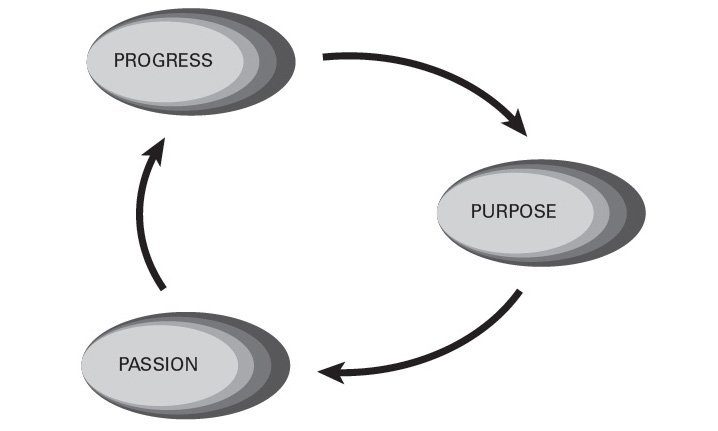 This text is taken from the original draft manuscript of Influential Leadership: A Leader’s Guide to Getting Things Done and is provided here to enrich your learning on the Strategic Influencer Programme.
This text is taken from the original draft manuscript of Influential Leadership: A Leader’s Guide to Getting Things Done and is provided here to enrich your learning on the Strategic Influencer Programme.
Introduction
Leadership is about driving progress towards a vision or goal with the help and support of others. The quality of leadership varies greatly as do the behaviours, skills and characteristics of good leaders. It seems that no two leaders are the same.
One thing common to all leaders is the need to influence others. They have to get people thinking, feeling and acting differently than they would otherwise have done. They have to create change in others. The more effective they at influencing those around them, the more progress they will make. They will also gain recognition for their leadership ability.
When leaders are effective influencers they are able to win over opposition, motivate people to go that extra mile and get others to innovate and collaborate towards the goal or vision. They all face challenges, but because of the way they lead through influence, objections, problems and road blocks are easily overcome.
To achieve influence, leaders need to do a wide variety of different things such as visioning, inspiring, listening and coaching. Sometimes they also have to exert discipline, reprimand and veto. The means of influence are diverse and effective leaders develop a keen sense of what is right, what will work and what to do in order to achieve the influence they need and get the result.
Leaders also have to be many things. It helps if they are charming, charismatic, demanding and tenacious. The long list of leader attributes doesn’t contain a definitive answer. This lack of clarity is caused by the reality that different environments require different attributes in their leaders. Different leaders for different places.
They also need to develop a deep understanding of their environment and the individuals involved. This enables them to adapt their behaviour with precision and focus their attention where it will get the best return. This helps them to build trust, loyalty and long term relationship while getting results fast.
Some leaders have big bold ideas that they are working towards. They have glimpsed the future, seen how the world will be and are able to communicate this to others with eloquence. These I call visionaries. Others have a strong orientation to the short term imperatives. They are great at delivering what the organisation needs right now in order to meet its targets and satisfy its stakeholders. These I call managers.
Managers struggle to find the time to look further ahead and so continue to keep doing what is asked of them. Visionaries struggle to get things moving because they are disconnected with the problems of today. Influential Leadership is intended to help you, as a leader, to bridge the gap between managers and visionaries. Rooted in the practical world while also striving towards a bigger, better future, this book will help you to get things done for today, and for tomorrow. Influential Leaders know where they are going, know where they are, and pursue practical ways of leading the way.
The Influential Leadership framework
Influential Leadership is a simple framework for applying practical influence in leadership situations. It aims to help leaders to achieve greater results today and to stretch them into a bigger and better future. It is predicated on three key beliefs:
- The primary work of a leader is to influence people towards a clear and ambitious vision of the future.
- Influence means getting people to do, think or feel differently, and preferably all three.
- Relentless focus is required on what needs to be influenced and the most effective means of achieving it.
The framework consists of three core elements which support each other:
- Progress: These are the results, both short term and long term that accumulate over time. Influential Leaders make significant progress, and fast.
- Purpose: From the long term vision down to the short term imperative, this is what the leader is aiming for. Influential Leaders do not sacrifice the short term for the long term or vice versa.
- Passion: The emotion and energy which is poured into the purpose by the Influential Leader. This creates the resilience and inspiration to continue making progress.
The order these have been placed in is important. You might think that Progress should have come last. It was placed first because most leaders today are not making enough progress in their short term objectives to create the time and the space to discover their longer term purpose. What I have found is that as people get faster as influencing progress on their immediate priorities, it isn’t long before they are looking around for new challenges. And this is just the time to begin stretching their vision and ambition.
With this order, Progress, Purpose and Passion become a virtuous circle. Each cycle increasing the stretch and the achievement as competence and confidence rises.

This book is not going to ignore the subject of Purpose and Passion, but it will place greater emphasis on Progress. This will keep it highly practical and of immediate value while also offering leaders the future potential to up the ante while keeping their feed firmly on the group.
In order to begin to make rapid and more significant Progress, leaders need to develop their knowledge, understanding and capability in five key areas. These have been derived from the work I have done over the last ten years learning about influence, and helping many others to become influential. In reality it merely segments the main topics into logical categories.
Power: The bottom line is that if you want to be successful as a leader you have to be strong and powerful. Building greater power requires exercise and practise. It is something which everyone has to some degree, and also something which everyone can improve upon. Power helps to make it much easier to get things done and frankly, forms the basis on which others do things for you.
Arena: Influential Leaders also need to be acutely aware of the way things work in the arena in which they are leading. What is actually happening within their organisation and in the wider world? External influences give shape to the way things work within an organisation. The strategy adopted by the organisation to succeed in its environment is the formal way in which things are shaped, but also belies the informal reality of the political complexity where individuals and agendas compete for prominence.
Strategy: Once the leader has developed a keen awareness of their environment, and is beginning to feel their power and strength growing, they need to put it into action and make decisions about exactly how they are going to move towards their goal. The goal will vary from their grand purpose down to creating more time to think about their grand purpose, and everything in between. Coming up with a clear strategy is vital for economy of effort and ease of execution. This is the route planning part of Influential Leadership.
Skills: When the strategy has been decided, Influential Leaders need to deploy their skills in order to make it happen. In this area of the framework you will learn the skills which are most critical to being great at influence, which a leader surely has to be. These skills are not difficult to understand, and most of them are also not that difficult to develop and use. Leaders who focus on these skills will quickly see their Influential Leadership rise.
Style: Aside from the actual skills, there are a variety of ways in which they can be used. The skill remains the same but the style of execution can change. Choosing the right style for the individual and situation the leader is working makes a vital different to the result. Get it wrong and people are easily distracted. Get it right and they will much more easily buy in to what the leader is saying and wanting.
Proficiency in all of these areas provides the means of getting things done and these will be covered in considerable depth as you move through the book. And you do need all five because they are inextricably linked and mutually supportive. The Influential Leader has to master all of them to fully realise their potential.
